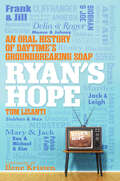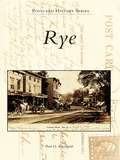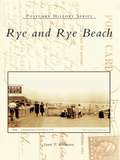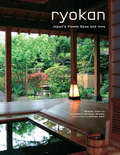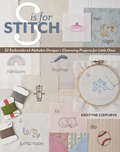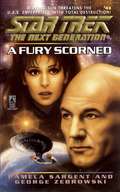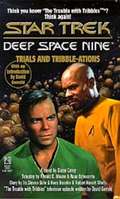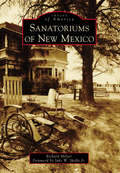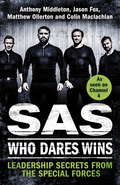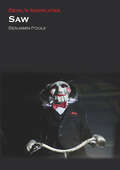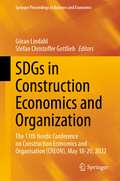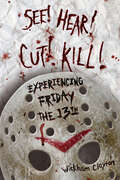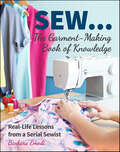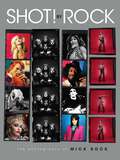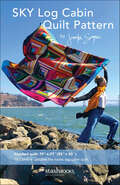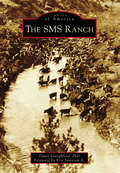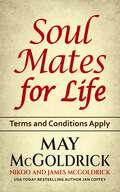- Table View
- List View
Ryan's Hope: An Oral History of Daytime's Groundbreaking Soap
by Tom Lisanti&“A must-have for Ryan&’s Hope fans, all soap fans, television fans, and future writers of books about soaps — to show how it should be done!&” —SoapHub &“Amazing…a gift to soap opera fans everywhere.&” —Marlena De LaCroix, Soaps for the Thinking FanIn the vein of the bestselling Nothing General About It and Always Young and Restless, a revelatory account of the pioneering Emmy Award-winning, beloved daytime drama— featuring the words of stars including Helen Gallagher, Malcolm Groome, Ron Hale, Ilene Kristen, Michael Levin, Ana Alicia, Roscoe Born, Catherine Hicks, Geoff Pierson, Andrew Robinson, and Gordon Thompson, along with writers, producers, directors and family members—plus never-before-seen photos and plot synopses. From the opening scene of its first episode, in which Mary Ryan walks jauntily down a New York City street to her family&’s neighborhood bar, it was clear that Ryan&’s Hope would be unlike every daytime soap that had come before. Indeed, from 1975 to 1989, the Emmy award-winning ABC TV serial drew viewers into the world of Maeve and Johnny Ryan, their children, friends, and extended family. This page-turning chronicle gathers memories and exclusive interviews to reveal the show&’s fascinating origin story—and explore why it&’s missed to this day. Ryan&’s Hope was set in a real city, within recognizable communities. The working-class, Irish-Catholic, immigrant Ryans were the core of a show that credibly tackled such topics as infidelity, addiction, religious faith, and women&’s rights. There was melodrama, to be sure, but also heart, depth, grit—provided by co-creators and head writers Claire Labine and Paul Avila Mayer. Labine and Mayer were also the executive producers in the early years, which gave them full control over their creation, from character backstories to lighting and costume. But there were also some missteps along the way, from the constant recasting of fan-favorite characters to ABC&’s ill-judged attempts to infuse the homey, family-oriented show with intrigue and adventure. Featuring the words of stars including Helen Gallagher, Malcolm Groome, Ron Hale, Ilene Kristen, Michael Levin, Ana Alicia, Roscoe Born, Catherine Hicks, Geoff Pierson, Andrew Robinson, and Gordon Thomson, along with writers, producers, production crew, and family members—plus never-before-seen photos and plot synopses—soap opera fans will find this insider account as captivating as the beloved show itself.
Rye
by Paul D. RheingoldRye, now a suburb of New York City, has a fascinating history dating from its founding in 1660. Due to its extensive waterfront on Long Island Sound, Rye has been home to several major amusement parks, as well as beaches and nearly a dozen clubs. These clubs have featured sailing, golf, and swimming, and numerous postcard scenes in Rye show the ways in which residents entertained themselves over the years. Rye also contains plentiful views of the churches and schools in town, which date back well into the 19th century. The town has had a number of famous private schools and institutions, including St. Benedict's Home for Colored Children and the Osborn. Scenes also show civic buildings, such as the fire stations, post offices, train stations, and the mansions of the wealthy.
Rye and Rye Beach (Postcard History)
by Lewis T. KarabatsosAlthough small, the town of Rye played a significant role in New Hampshire's history and in nineteenth-century lifestyle and recreation. From its beginnings in 1623, Rye was predominantly a farming and fishing community. In the years prior to the Civil War, however, local entrepreneurs recognized the potential of their seacoast location and began catering to the needs of wealthy Victorians seeking a temporary escape from urban living. These entrepreneurs exploited the restorative powers of the ocean and established boardinghouses and grand hotels that gained national recognition. By the 1890s, the Rye Beach area had peaked as a summer resort destination and began to evolve into a summer residence colony. Houses of grand scale and variety began to appear. Later, with the introduction of the automobile and the extension of cable-car systems up the coast, Rye and Rye Beach became more accessible for day trips to the ocean.
Ryokan: Japan's Finest Spas and Inns
by Akihiko Seki Elizabeth Heilman BrookeWith over 180 color photographs and extensive commentary, this book showcases the beauty of Japanese inn, or ryokan.<P><P>Featured are both old and new-from inns with a history dating back a thousand years to modern inns with the latest facilities that nonetheless capture the spirit of old Japan. Each of the properties has been handpicked by the authors for their strong design aesthetic, commitment to service and purity of their spring waters. The photographs showcase the resorts at their best, and accurately express the unique architectural design of each ryokan.Each chapter begins by introducing the area surrounding the inns and their spas, or onsen, and provides a background of its local history, culture and traditions, as well as the natural environment. The text provides information on the design and development of each ryokan, and descriptions of the owners and their clientele.For those planning a visit to an onsen, this book provides contact details and information on the number of rooms, type of facilities and food, as well as vital information on travel and booking procedures and whether English is spoken. For those fascinated by Japanese culture and design, this book is an absolute delight.
S is for Stitch: 52 Embroidered Alphabet Designs + Charming Projects for Little Ones
by Kristyne CzepurykEmbroidery and needlework projects you can make for little boys and girlsA is for angel, B is for baseball, and C is for cupcake! Stitch up lots of adorable projects from A to Z with these two sets of alphabet-themed embroidery patterns for little girls and boys. Projects include quilts, pillows, soft blocks, and wall art for the nursery to help your little ones learn the alphabet, or just to make them smile. Kristyne Czepuryk’s designs are wonderfully detailed, yet easy to try with any skill level. Learn basic stitches and tips for combining floss and fabrics, plus get ideas for embroidering on clothing and other store-bought items, too.Praise for S Is for Stitch“The motifs are sweet, and Czepuryk provides plenty of ideas for projects beyond the quilt, such as embellishing clothing or soft fabric blocks. Embroiderers who enjoy designs for children will appreciate Czepuryk’s cute motifs.” —Library Journal“This book is filled with delightful embroidery alphabet designs for children . . . and a variety of projects—from baby blocks to pillows to quilts—to use the embroidery designs in.” —Quilter's Connection Magazine“What’s not to love about a collection of 52 small embroidery designs along with loads of ideas on how to incorporate them into charming and useful gifts for little boys and girls? . . . There’s also a good introductory section on embroidery floss, fabric, transferring designs, trimming embroidered blocks and assembling a quilt.” —Australian Homespun Magazine“You’ll love Kristyne Czepuryk’s adorable alphabet-themed embroidery designs—one set for boys and one for girls—in S is for Stitch. The book includes embroidery basics and stitch directions, as well as 7 projects—from quilts to soft blocks. What a fun way to learn hand embroidery!” —Quiltmaker Magazine
S/trek Ds9 #19 The Tempest (Star Trek #19)
by Susan WrightWhen a ferocious plasma storm strikes the entire Bajoran system, Deep Space NineTMbecomes a port under siege, filled to overflowing with stranded space travelers, unpredictable aliens, and Klingon smugglers. Wof and Odo find themselves tested to the limit as they struggle to control the chaos that has consumed the station. But even greater danger faces Dax and botanist Keiko O' Brian when they must fly a runabout into the very heart of the storm - and encounter a stange new form of life!
S/trek Ng 43: A Fury Scorned (Star Trek #43)
by Pamela SargentWith their sun about to go nova, the people of Epictetus III face annihilation. Although the U.S.S. Enterprise has come to lead the rescue operation, there is no way to evacuate a population of over twenty million, leaving Captain Picard to make an agonizing decision. Should he try to salvage the planet's children, its greatest leaders and thinkers, or its irreplaceable archeological treasures? No matter what he decides, millions must be sacrificed -- unless another solution can be found. With time running out, Data proposes a revolutionary scientific experiment that could save all of Epictetus III, or doom both the planet and the Enterprise as well.
S/trek Trials And Tribble-ations (Star Trek)
by Diane CareyAlmost a century ago, Captain James T. Kirk and the crew of the Starship Enterprise first encountered the irresistible (and astonishingly prolific) life-form known as the Tribbles5, resulting in one of the most unususal adventures in the annals of Starfleet. Now Captain Benjamin Sisko and the crew of the Defiant are transported back in time to that historic occasion, where Darvin, a devious Klingon spy, plots revenge against Captain Kirk. Using the seemingly harmless tibbles, Darvin attempts to destroy Kirk -- but for the misplaced residents of Deep Space Nine saving the original Enterprise willbe nothing but ""tribble."" An exciting new novel based on the most mind-boggling STAR TREK: DEEP SPACE NINE adventure of them all!
SANATORIUMS of New Mexico
by Richard Melzer Jake W. Spidle Jr.Tuberculosis, also known as consumption, the White Plague, or simply TB, was the number-one killer in the United States in the late 19th and early 20th centuries. Many physicians of the era advised their patients to chase the cure for tuberculosis in the Southwest, where the region's clean, dry, fresh air, high altitude, and sunshine offered relief for most and recovery for some. New Mexico, called the "well country," was particularly eager to promote itself as a mecca for lungers with the coming of the railroad to the territory in 1880 and the creation of many new hospitals, known as sanitariums or sanatoriums ("sans"), which specialized in the treatment of TB. This is a brief history of New Mexico's sans, their patients, and the doctors, nurses, and staff who served them during the golden age of the TB industry, from the turn of the 20th century to the eve of World War II.
SAS: Leadership Secrets from the Special Forces
by Jason Fox Anthony Middleton Matthew Ollerton Colin MaclachlanLife and leadership lessons from the Special Forces, from the stars of Channel 4 series SAS: Who Dares Wins - including Sunday Times bestselling author of FIRST MAN: LEADING FROM THE FRONT, Ant MiddletonAre you up to the challenge of SAS leadership? Only the best will succeed... Britain's SAS (Special Air Service) has an unparalleled reputation for soldiering excellence. Their skills and techniques have been perfected in the most demanding environments imaginable, but many of these can also be used in our everyday lives. This book takes situations all of us will experience during our lives and presents tactical lessons drawn from SAS training and battlefield experience. Its four authors - stars of the hit Channel 4 show SAS: Who Dares Wins - how their finely honed understanding of how to handle extreme challenges can be applied in any environment. Their advice on negotiation, people management, self-motivation and resilience, among other things, can transform your performance in a whole range of scenarios: from buying a house, nailing a job interview, and the experience of dealing with rejection, to maintaining a diet, or managing that pushy colleague at work.This is the ultimate guide to leadership and personal achievement.
SAW
by Ben PooleLike all game changers within the horror genre, SAW was an independent success, a low-budget champion that flourished without the patronage of a big studio. Not bad for the most successful horror franchise ever, which has spawned subsidiary media and masses of merchandise, including a theme park rollercoaster ride. What is it about SAW that attracted such a following? In his contribution to the "Devil's Advocates" series, Ben Poole considers the SAW phenomenon from all aspects of film and media studies - from its generic pedigree in both literature and film, to the visceral audience pleasures ("what would I do?") of the text, to the contrasting representations of men and women and the film's implicit criticism of masculinity.
SAW (Devil's Advocates)
by Ben PooleLike all game changers within the horror genre, SAW was an independent success, a low-budget champion that flourished without the patronage of a big studio. Not bad for the most successful horror franchise ever, which has spawned subsidiary media and masses of merchandise, including a theme park rollercoaster ride. What is it about SAW that attracted such a following? In his contribution to the "Devil's Advocates" series, Ben Poole considers the SAW phenomenon from all aspects of film and media studies – from its generic pedigree in both literature and film, to the visceral audience pleasures ("what would I do?") of the text, to the contrasting representations of men and women and the film's implicit criticism of masculinity.
SDGs in Construction Economics and Organization: The 11th Nordic Conference on Construction Economics and Organisation (CREON), May 18-20, 2022 (Springer Proceedings in Business and Economics)
by Göran Lindahl Stefan Christoffer GottliebThis book examines how research in construction economics and organization contributes to the achievement of the SDGs. Featuring selected contributions from the 11th Nordic Conference on Construction Economics and Organisation (CREON 2022) held in Copenhagen, Demark and Malmö, Sweden, the contributions of this book explore the ways in which research in construction economics and organization assists in building resilient infrastructure, fostering green innovations and contributes to sustainable economic growth. Each contribution relates to one or more individual SDG and describes how the research contributes to the understanding of construction management and economics.
SEE! HEAR! CUT! KILL!: Experiencing Friday the 13th
by Wickham ClaytonSean S. Cunningham and Victor Miller’s Friday the 13th franchise is one of the most successful horror film franchises in history. To date, it includes twelve movies, a television show, comic books, and video games, among other media. In SEE! HEAR! CUT! KILL! Experiencing “Friday the 13th,” Wickham Clayton explores several aspects of the films including how the technical aspects relate to the audience, their influence on filmmaking, and the cultural impact of the franchise. Clayton looks at how perspective is established and communicated within the Friday the 13th films, which is central to the way the audience experiences and responds emotionally to these movies. Then he considers how each sequel gives viewers, whether longtime fans or new audiences, a “way in” to the continuous story that runs through the series. Clayton also argues that the series has not developed in isolation. These films relate to contemporary slasher films, the modern horror genre, and critically successful Hollywood films in general. They reflect popular trends of film style and often act as key examples in the genre and beyond.
SEW . . . The Garment-Making Book of Knowledge: Real-Life Lessons from a Serial Sewist
by Barbara EmodiExperienced sewing instructor and blogger Barbara Emodi shares her sewing wisdom to help readers get started, get started back up, or hone their existing garment-sewing skills. Not a sewing reference book as much as a book of experience, this is a book that will make a novice sewist say, “Oh, so that’s why you do that,” make a practiced sewist think, “Now that’s a neat trick,” and make a very experienced sewist smile and say, “That is sooo true!” Take advantage of her thoughts, tips, and tricks on the benefits of sewing, the importance of fit, basic techniques, available tools, patterns, and materials, and so much more. • Droll, well-informed, readable, interesting, and useful— the how-to book of sewing wisdom you always wanted • Get the inside scoop on sizing and alteration, patternless sewing, what to sew and what to buy, and many other topics, with mini lessons sprinkled throughout • Tips and ideas on choosing and using the best fabric, gear, and sewing machines
SHOT! by Rock: The Photography of Mick Rock
by Mick RockBorn in 1948 in Hammersmith, London, Michael Rock became a photographer after graduating from college, and developed his visual style with photos of the local rock music scene in England. Soon thereafter his photography career took off, going higher and higher with each new musician he shot for. His work is embodied in this text, full of luscious, color-saturated photography of some of the most dynamic and enthralling musical acts and stars in rock history—and likewise filled with amazing and amusing behind-the-scenes stories of musicians from Mick Jagger to Miley Cyrus and beyond. A sure-fire hit with rock and musical history fans!
SKY Log Cabin Quilt Pattern
by Jennifer SampouPlay with color and value using ombré fabrics Modern and traditional design cross paths in this stunning Log Cabin quilt. Quilters of every level can create this simple yet versatile quilt. Characterized by strips (logs) surrounding squares, the repeated squares give the quilt pattern depth, and colors create dimension. The block-making approach is thoughtful, with value and color placement studied even though the overall effect has a scrappy appeal. Look closer and see how the blocks create a secondary jumbo star pattern. Jennifer Sampou is known for her gorgeous ombré fabrics, which she incorporates into the Log Cabin quilt. The final quilt size is 77” x 77” with the option of a 93” x 93” quilt included A beautiful quilt that makes the most of your ombré fabrics Tips for building large blocks and making improvisational choices
SMS Ranch, The (Images of America)
by Dawn Youngblood Eric Swenson Jr.Few images captivate the Western imagination more than the Texas cowboy at home on the range, herding, corralling, throwing and branding cattle, bronc busting, dining from chuck wagons, and sleeping under the stars. The SMS Ranch in the early 1900s was exactly such a place. Spanning hundreds of thousands of acres and holding land in 12 Northwest Texas counties, the SMS was formed by early Swedish immigrant to the Republic of Texas Swante Magnus Swenson. Swenson, a good friend of Sam Houston, had a penchant for wise financial decisions and, by the late 1800s, lived in New York with offices on Wall Street. Swenson sent his two sons to manage his vast Texas landholdings. In 1902, they hired legendary cattleman Frank Hastings to manage the SMS Ranch, headquartered in Stamford, Texas, north of Abilene and west of Fort Worth. Hastings�s wife, Laura, and daughter Ruth photographed life on the ranch, and many professional photographers visited the SMS as well, leaving a rich visual legacy.
SORT YOUR LIFE OUT: 3 Steps to Transform Your Home & Change Your Life
by The BBC teamThe first official book from the life-changing BBC One show, Sort Your Life Out will have you falling back in love with your home in three simple steps:1. STRIP - how to let go and clear out the clutter (when you don't have a warehouse to hand)!2. SORT - time to sell, donate, recycle and upcycle.3. SYSTEMISE - learn how to organise, fold and store in a way that is manageable and sustainable.Filled with every tip and trick from your favourite experts Stacey, Dilly, Iwan and Rob, this empowering book will give you the tools to transform your home and get that Sort Your Life Out mindset.
SOUL MATES FOR LIFE: More Than Just a Greeting Card—A Gift That Lasts
by Jan Coffey May McGoldrick Nikoo McGoldrick James McGoldrickMore Than Just a Greeting Card—A Gift That Lasts This little book about relationships is more meaningful than any Valentine's card, birthday card, or anniversary card you could give your partner. While cards are read once and set aside, this book offers insights, inspiration, and heartfelt connection that will stay with you both long after the occasion has passed. Whether celebrating love, strengthening your bond, or simply expressing your feelings, this book is a lasting reminder of what truly matters—your relationship. And if you're t ired of love stories that feel more scripted than a Hallmark movie, buckle up for something wilder—Nikoo and Jim McGoldrick, self-proclaimed cosmic stalkers, are here to prove that true love doesn't just last a lifetime… it survives multiple. (Or at least, that's their story, and they're sticking to it.) What's their secret? Unwavering commitment, daily communication, and the kind of mutual respect that keeps them from turning minor disagreements into full-blown historical reenactments. From health scares to heated debates over who left the light on, they tackle life's storms with humor, heart, and an unshakable 'us against the world' attitude. This isn't just romance—it's embracing quirks, laughing through the chaos, and knowing that sometimes, the best date night is just surviving the grocery store together. Want to know how they keep the spark alive? Simple: long hugs, short grudges, and the firm belief that everything is better when we do it together. Ready to unlock the secrets of a love that endures? (And maybe pick up some relationship survival tips along the way?)
SOUTHERN LIVING 101 Decorating Ideas: The Ultimate Guide to Southern Style
by The Editors of Southern LivingSouthern homes have always been known for being warm and welcoming, whether a grand historic house or a small cottage or bungalow. Now the editors of Southern Living, the authority on all things Southern, bring you a special edition of Southern Living guaranteed to take your home style to the next level. Whether you're designing your dream living room from the hardwood floor up, or just tweaking the look of an entry hall or completely redoing the whole kitchen, Southern Living shares their favorite ideas and inspirations.Chock-full of expert advice, including how to mix color and pattern like a pro to the best ways to transform a flea market find, the tips and tricks included in 101 Decorating Ideas cover every room in the house and include a wide range of ideas--some that can be done by yourself and within a day, to larger projects that might require a little more time and assistance, but all with beautiful photography that will inspire you along the way and help you transform your home into a place you can't wait to get back to every day.
SOUTHERN LIVING Small Space Ideas
by The Editors of Southern LivingBring big ideas to small spaces!Never let small spaces keep you from big style. Live large with 165 stylish ideas for using every inch of kitchens, bedrooms, offices, closets, bathrooms, and more.Southern Living Small Space Ideas showcases some of the most beautiful rooms from homes throughout the South, each one packed with great ideas for organizing and maximizing even the most challenging spaces. An idea gallery offers 27 clever solutions, all with measurements, clear descriptions, and glowing photography to help you create the home of your dreams, built around your own personal style. Then explore close-up profiles of eight inviting, practical small homes created by renowned designers like Cathy Kincaid, David Mitchell, and P. Allen Smith. These inspiring houses, apartments, cottages, and cabins reveal exactly how to triumph over tight spaces-and turn tiny into tremendous!
SOUTHERN LIVING Small Space Style: 185 Ways to make Any House Live Large
by The Editors of Southern LivingDiscover the art of living small! If you think outside the box you can fit entertaining and living spaces into a tiny, tricky layout!
SOUTHERN LIVING Style Guide: Decorating Tips and Tricks from the South's Most Beautiful Homes
by The Editors of Southern LivingLearn how to live Southern in every room of the house--from entryways and living rooms to kitchens and bedrooms--with more than 200 ideas for creating stylish spaces with paint, furniture, fabrics, accessories, and more.
SOUTHERN LIVING Vintage Style: 96 Ways to Decorate with Heirlooms, Collections, & More
by The Editors of Southern LivingFrom old paintings and antique pottery, to chippy furniture and new-again chintz, Southern Living and three Southern makeover experts show you that, with a little paint, fabric, and inspiration, there's no such thing as a lost cause.
